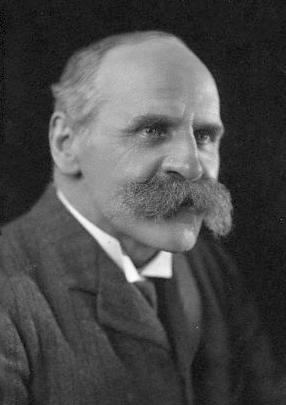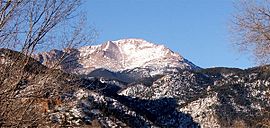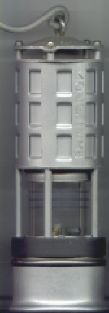John Scott Haldane facts for kids
Quick facts for kids
John Scott Haldane
FRS
|
|
|---|---|
 |
|
| Born | 2 May 1860 Edinburgh
|
| Died | 14 March 1936 (aged 75) Oxford
|
| Education | Edinburgh Academy |
| Alma mater | University of Edinburgh Friedrich Schiller University of Jena |
| Known for | Black Veil Respirator Haldane effect Haldane's decompression model |
| Spouse(s) | Louisa Kathleen Coutts Trotter |
| Children | J. B. S. Haldane, Naomi Mitchison |
| Awards | Fellow of the Royal Society, member of the Royal College of Physicians and of the Royal Society of Medicine; many honorary degrees |
| Scientific career | |
| Fields | Physiology, medicine |
| Institutions | University of Glasgow New College, Oxford University of Birmingham |
John Scott Haldane CH FRS (2 May 1860 – 14/15 March 1936) was a British doctor and physiologist. He was known for his brave experiments on himself, which led to many important discoveries about the human body and how gases work. He even sometimes included his son, the famous scientist J. B. S. Haldane, in his studies. Haldane would lock himself in sealed rooms, breathing different gas mixtures, even dangerous ones, to see how they affected his mind and body.
Haldane also visited many mining disaster sites to find out what caused them. When poison gas was used in World War I, he went to the front lines. He was asked by Lord Kitchener to identify the gases. This work helped him invent an early gas mask called the black veil.
His research into decompression sickness helped create the idea of staged decompression. This led to the first reliable decompression tables, which are still used today in updated forms for divers.
Contents
Early Life and Family
John Scott Haldane was born in Edinburgh, Scotland, on May 2, 1860. His father was Robert Haldane. His mother was Mary Elizabeth Burdon-Sanderson. John had three siblings: Elizabeth Haldane, William Stowell Haldane, and Richard Burdon Haldane, 1st Viscount Haldane. His uncle, John Scott Burdon-Sanderson, was also a physiologist.
Education and Personal Life
Haldane went to Edinburgh Academy and then to the University of Edinburgh. He also studied at the Friedrich Schiller University of Jena in Germany. He finished his medical degree from the University of Edinburgh Medical School in 1884. After that, he worked as a demonstrator at University College, Dundee. From 1907 to 1913, he was a professor of Physiology at Oxford University.
In 1891, John Scott Haldane married Louisa Kathleen Coutts Trotter. They had two children. Their son was the famous scientist J. B. S. Haldane. Their daughter was the author Naomi Mitchison.
Career and Achievements
Haldane held many important positions during his career. He was a lecturer at the University of Glasgow and a Fellow at New College, Oxford. He was also an Honorary Professor at the University of Birmingham. He received many awards and honors. He became a member of the Royal Society in 1897. In 1916, he received the Royal Medallist award. He was also made a Companion of Honor in 1928 for his work on diseases related to jobs. In 1934, he received the Copley Medallist award.
Death
John Scott Haldane passed away in Oxford on March 14 or 15, 1936. He died from pneumonia. He had just returned from a trip to Persia. He went there to study cases of heat stroke in oil refineries.
Key Discoveries and Inventions
Breathing and Gas Masks
Haldane was an expert on how we breathe and the effects of gases. He invented the Black Veil Respirator, an early gas mask, during World War I. This mask helped protect soldiers from poison gas.
He also studied lung diseases, like silicosis. This disease is caused by breathing in silica dust. After his work with poison gases, he helped people who were hurt by gas warfare. He developed oxygen treatments, including the oxygen tent.
Haldane helped us understand how our breathing is controlled. He discovered the Haldane effect in haemoglobin (the part of blood that carries oxygen). He found that blood without much oxygen can pick up more carbon dioxide. This helps our bodies get rid of carbon dioxide.
He also started The Journal of Hygiene, a scientific magazine.
Diving Safety
In 1907, Haldane created a decompression chamber. He used it to experiment and make underwater diving safer. He developed the first decompression tables. These tables tell divers how to come up slowly from deep water to avoid getting sick. He did many experiments with animals and divers in deep Scottish lakes.
The math model he used for these tables is still used today, though it has been updated. In 1908, he published his findings in the Journal of Hygiene. He also found that divers sometimes passed out because too much carbon dioxide built up in their helmets. He figured out how much air was needed to keep divers safe.
Mine Safety
Haldane studied how different gases work. He investigated many mine disasters. He focused on the toxic gases that killed most miners after explosions. These gases included afterdamp, blackdamp, and whitedamp. He explained how a flame safety lamp could detect dangerous gases. For example, the flame would get taller if firedamp was present, or go out if there was chokedamp. Even though electronic detectors are used now, flame lamps are still useful.
He found that carbon monoxide was the deadly gas in afterdamp. This gas forms after fires. He saw that miners who died from it had cherry-pink skin. This was because carbon monoxide replaces oxygen in the blood, causing suffocation. His research helped him design respirators for rescue workers. He even tested the effects of carbon monoxide on himself in a closed room.
In the late 1890s, Haldane suggested using small animals like white mice or canaries in mines. These animals have faster body systems. They would show signs of gas poisoning before the miners did. This gave an early warning of dangerous carbon monoxide levels. In British mines, canaries were replaced by electronic gas detectors in 1986.
High Altitude Research

Haldane was a pioneer in studying how the body reacts to low air pressure. This is what people experience at high altitudes. In 1911, he led a trip to Pike's Peak to study how low air pressure affected breathing. Pike's Peak is still a place for breathing research today.
Sewer Gas Investigations
Besides his work in mines, Haldane also studied the air in enclosed places like wells and sewers. He found that the air in the sewers under the House of Commons had surprisingly low levels of bacteria. During this research, he investigated deaths of workers in a sewer. He showed that hydrogen sulfide gas poisoning was the cause.
See also
 In Spanish: John Scott Haldane para niños
In Spanish: John Scott Haldane para niños
- Decompression (diving)
- Haldane's decompression model


